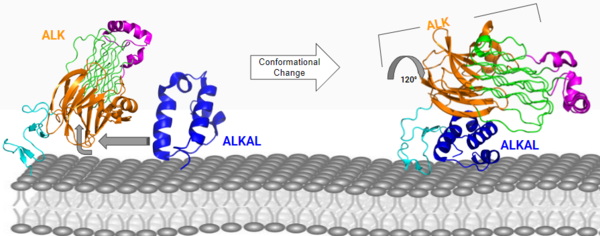Sandbox Reserved 1712
From Proteopedia
(Difference between revisions)
| Line 16: | Line 16: | ||
The first step to the activation of ALK is to bind the ALK activating ligand (ALKAL) to ALKr. ALKAL is a triple alpha-helix polypeptide structure that signals for a conformational change of ALK. What allows ALKAL to interact with ALKr is the cell membrane. The negatively charged phosphate groups on the cell membrane interact with a highly conserved positively charged <scene name='90/904317/Alkalbindingsurfacewmembrane/1'>helix</scene> on ALKAL that faces the membrane. These <scene name='90/904317/Alkal1membraneinteraction/1'>residues that interact with the cell membrane</scene> [https://www.rcsb.org/structure/7MZZ (7MZZ)] guide ALKAL to ALKr and correctly positions ALKAL for its binding surface to face ALKr's binding surface, which allows for a more favorable interaction. | The first step to the activation of ALK is to bind the ALK activating ligand (ALKAL) to ALKr. ALKAL is a triple alpha-helix polypeptide structure that signals for a conformational change of ALK. What allows ALKAL to interact with ALKr is the cell membrane. The negatively charged phosphate groups on the cell membrane interact with a highly conserved positively charged <scene name='90/904317/Alkalbindingsurfacewmembrane/1'>helix</scene> on ALKAL that faces the membrane. These <scene name='90/904317/Alkal1membraneinteraction/1'>residues that interact with the cell membrane</scene> [https://www.rcsb.org/structure/7MZZ (7MZZ)] guide ALKAL to ALKr and correctly positions ALKAL for its binding surface to face ALKr's binding surface, which allows for a more favorable interaction. | ||
===Conformational Change=== | ===Conformational Change=== | ||
| - | ALKAL <scene name='90/904318/Alk-alkal_binding_surface/2'>binds</scene> to ALKr at the TNFL domain, which has important negatively charged residues that form <scene name='90/904318/Binding_surface_with_residues/3'>ionic bonds</scene> with positively charged residues on ALKAL. These bonds initiate the conformational change, as these residues can only come into close proximity with each other if the conformational change occurs. The PXL and GlyR domains hinge forward when the change is initiated<ref>DOI: 10.1038/s41586-021-04140-8</ref> (Figure 2). Glu978, Glu974, Glu859, and Tyr966 are the residues of ALKr that form these bonds with Arg123, Arg133, Arg136, Arg140, and Arg117 of ALKAL. Once the ALK-ALKAL complex is formed, the <scene name='90/904317/Dimer_full_colored/ | + | ALKAL <scene name='90/904318/Alk-alkal_binding_surface/2'>binds</scene> to ALKr at the TNFL domain, which has important negatively charged residues that form <scene name='90/904318/Binding_surface_with_residues/3'>ionic bonds</scene> with positively charged residues on ALKAL. These bonds initiate the conformational change, as these residues can only come into close proximity with each other if the conformational change occurs. The PXL and GlyR domains hinge forward when the change is initiated<ref>DOI: 10.1038/s41586-021-04140-8</ref> (Figure 2). Glu978, Glu974, Glu859, and Tyr966 are the residues of ALKr that form these bonds with Arg123, Arg133, Arg136, Arg140, and Arg117 of ALKAL. Once the ALK-ALKAL complex is formed, the <scene name='90/904317/Dimer_full_colored/7'>dimerization</scene> of two ALK-ALKAL complexes occurs. The main driving force of the interaction between two ALK-ALKAL complexes that dimerize are hydrophobic interactions of the PXL loop of one ALKr with the other complex's ALKAL and TNFL domain of ALKr. This dimer of two ALK-ALKAL complexes is the active form of ALK, and it is now able to perform its main function of phosphorylation. |
===Role of Activated ALK=== | ===Role of Activated ALK=== | ||
Once the ALKAL binds with ALK and dimerizes with another ALK-ALKAL complex, this activated conformation also initiates a conformational change of the intracellular kinase domain of ALK. This causes an autophosphorylation of several tyrosine residues of this domain, activating a signaling cascade with its kinase activity. | Once the ALKAL binds with ALK and dimerizes with another ALK-ALKAL complex, this activated conformation also initiates a conformational change of the intracellular kinase domain of ALK. This causes an autophosphorylation of several tyrosine residues of this domain, activating a signaling cascade with its kinase activity. | ||
Revision as of 03:34, 14 April 2022
Anaplastic Lymphoma Kinase receptor
| |||||||||||
References
- ↑ Huang H. Anaplastic Lymphoma Kinase (ALK) Receptor Tyrosine Kinase: A Catalytic Receptor with Many Faces. Int J Mol Sci. 2018 Nov 2;19(11). pii: ijms19113448. doi: 10.3390/ijms19113448. PMID:30400214 doi:http://dx.doi.org/10.3390/ijms19113448
- ↑ Huang H. Anaplastic Lymphoma Kinase (ALK) Receptor Tyrosine Kinase: A Catalytic Receptor with Many Faces. Int J Mol Sci. 2018 Nov 2;19(11). pii: ijms19113448. doi: 10.3390/ijms19113448. PMID:30400214 doi:http://dx.doi.org/10.3390/ijms19113448
- ↑ Murray PB, Lax I, Reshetnyak A, Ligon GF, Lillquist JS, Natoli EJ Jr, Shi X, Folta-Stogniew E, Gunel M, Alvarado D, Schlessinger J. Heparin is an activating ligand of the orphan receptor tyrosine kinase ALK. Sci Signal. 2015 Jan 20;8(360):ra6. doi: 10.1126/scisignal.2005916. PMID:25605972 doi:http://dx.doi.org/10.1126/scisignal.2005916
- ↑ Li T, Stayrook SE, Tsutsui Y, Zhang J, Wang Y, Li H, Proffitt A, Krimmer SG, Ahmed M, Belliveau O, Walker IX, Mudumbi KC, Suzuki Y, Lax I, Alvarado D, Lemmon MA, Schlessinger J, Klein DE. Structural basis for ligand reception by anaplastic lymphoma kinase. Nature. 2021 Dec;600(7887):148-152. doi: 10.1038/s41586-021-04141-7. Epub 2021, Nov 24. PMID:34819665 doi:http://dx.doi.org/10.1038/s41586-021-04141-7
- ↑ Reshetnyak AV, Rossi P, Myasnikov AG, Sowaileh M, Mohanty J, Nourse A, Miller DJ, Lax I, Schlessinger J, Kalodimos CG. Mechanism for the activation of the anaplastic lymphoma kinase receptor. Nature. 2021 Dec;600(7887):153-157. doi: 10.1038/s41586-021-04140-8. Epub 2021, Nov 24. PMID:34819673 doi:http://dx.doi.org/10.1038/s41586-021-04140-8
- ↑ De Munck S, Provost M, Kurikawa M, Omori I, Mukohyama J, Felix J, Bloch Y, Abdel-Wahab O, Bazan JF, Yoshimi A, Savvides SN. Structural basis of cytokine-mediated activation of ALK family receptors. Nature. 2021 Oct 13. pii: 10.1038/s41586-021-03959-5. doi:, 10.1038/s41586-021-03959-5. PMID:34646012 doi:http://dx.doi.org/10.1038/s41586-021-03959-5
Student Contributors
- Drew Peters
- Hillary Kulavic



